![]()
By lyenochka
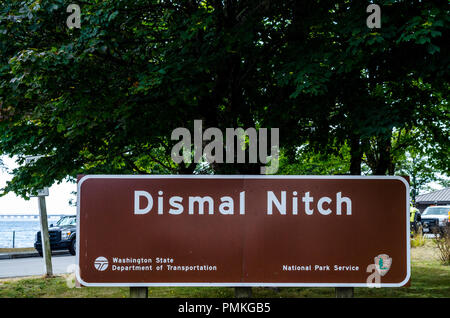
We pass this place when driving up from the Oregon-Washington border and always laugh at the name. It sounds like it came straight out of some Dr. Seuss story. (I imagine something like “A snitch who’s a witch ends up in a ditch of a dismal nitch.”)
Lewis and Clark’s expedition was stuck in this place in 1805. They were supposed to meet up with the last trading ship of the season, but a severe winter storm forced them to take cover in this cove for six days. They were out of supplies and food, and morale was low. It’s understandable that Captain William Clark referred to the place as “that dismal little nitch.” Even though in later years it bore another name (Megler Cove), in 2005 it was renamed “Dismal Nitch.”
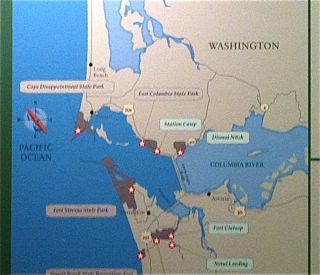
When President Jefferson sent the Corps of Discovery on their mission, he envisioned them finding woolly mammoths and meeting with Welsh-speaking Native Americans. The latter was from a tradition that a Welsh prince, Madoc ab Owain Gwynedd, went to America in 1170 and intermarried with a native and started a tribe. This was a popular medieval story which apparently caught the imagination of our third president. But the real goal of reaching the Pacific Ocean was achieved after the darkest hour for the intrepid team at Dismal Nitch.
But Dismal Nitch isn’t the only depressing name you will find in Washington. There’s Deception Pass which is between Fidalgo and Whidbey Islands. Captain George Vancouver named it that after he felt he was deceived about the narrowness of the passage.
Another disappointed sea explorer, John Mears, failed to get to the Columbia River in 1788. He changed the cape’s name from San Roque to Cape Disappointment.
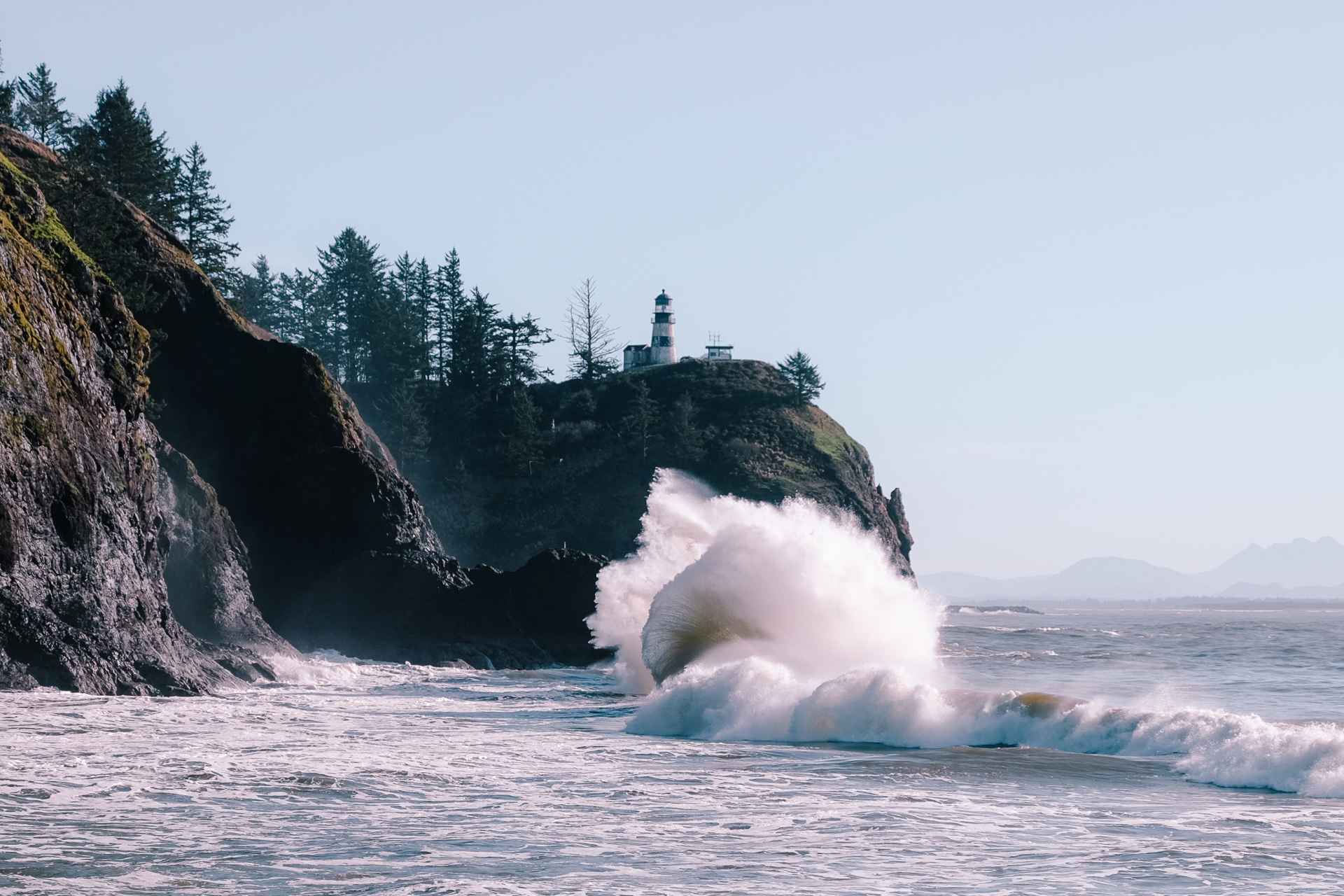
In 1841, U.S. Navy Commander Charles Wilkes named a striking outcropping of land Point Defiance. He thought it would be a great place for military defense operations. President Andrew Jackson set aside this 640-acre area for the military, but eventually it was given to the city of Tacoma. It’s now the place for Point Defiance Zoo and Aquarium.

But before Europeans came to rename places, Native peoples had already assigned place names. Some of the tribes were not pleased to see these foreign fur traders. After several groups were massacred, the island where these killings took place earned the name Destruction Island in English and Isla de Dolores in Spanish (Island of Sorrows). There were a dozen or so shipwrecks there, too, so perhaps, that was another reason for the name.

But the list doesn’t end there. Other place names include Cape Disappointment, Obstruction Island, Massacre Bay, Foulweather Bluff, Useless Bay, and Point No Point. Perhaps all the bleak, rainy weather infected the brains of the explorers who were stuck in western Washington. Their sunshine-deprived minds could only dream up depressing names. But these are rather scenic places, and I think it shows Washingtonians have a sense of humor in keeping the names. We even have a city named George, Washington.
| Author Notes |
Notes:
This is a multi-author book. (Thanks to Karenina for suggesting it.) Please feel free to share about the oddest names of places and some of their unique histories by adding your chapter. Sources: https://www.nps.gov/places/dismal-nitch.htm https://en.wikipedia.org/wiki/Dismal_Nitch https://en.wikipedia.org/wiki/Madoc https://kuow.org/stories/cape-disappointment-deception-pass-what-s-depressing-names/ https://www.visitlongbeachpeninsula.com/experience-joy-coastal-places-depressing-names/ |
![]()
By lyenochka
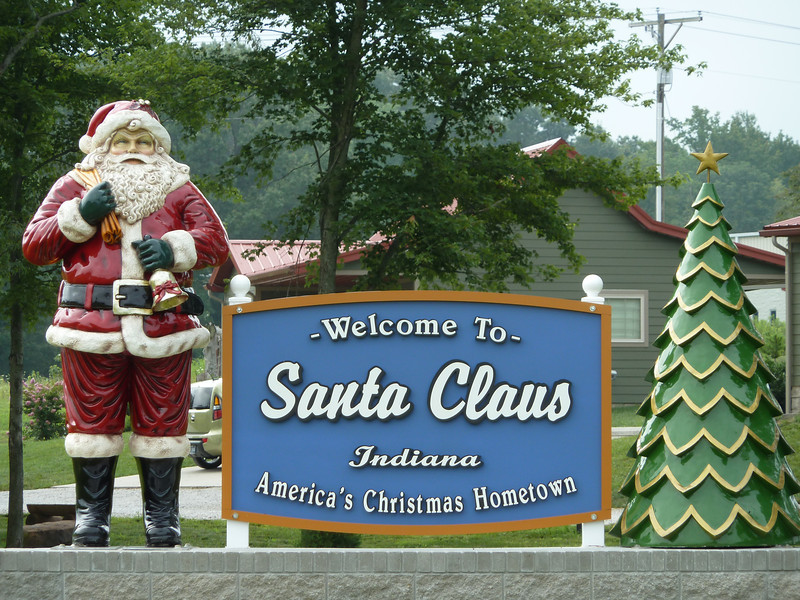
When it comes to fascinating place names, no state has more of them than my home state of Indiana. Indiana State University professor emeritus of English Dr. Ronald Baker wrote the book on Indiana place names, From Needmore to Prosperity: Hoosier Place Names in Folklore and History. According to legend, Needmore was founded during Grover Cleveland’s presidency, and the administration complained that the people were always ‘needing more.” Prosperity was founded during the canal boom, and the residents hoped the name would bring them prosperity, Baker's book tells the story of 4,000 place names in Indiana.
Although Indiana has a lot of rich farmland and rolling hills and valleys, several towns chose to call themselves Mount. The state has Mount Healthy, so named because it is located on high ground away from “miasmatic vapors.” There are also Mount Etna, named after you-know-what, Mount Olive, Mount Pisgah, Mount Pleasant, and Mount Olympus.
The Hoosier state is blessed with plenty of saints, too. We have Saints James, John, Peter, and Thomas—enough to fill the New Testament. On the female side, there are Saint Bernice, Saint Magdelin, and Saint Mary’s of the Woods.
Many of the state’s place names end in the suffixes “dale, “burg,” or “ville.”
“Dale” means a valley or hollow. We have Robertsdale, Bloomingdale, Greendale, and Hillsdale. One of the towns, Roachdale, was named after Judge Roach, founder of the Monon Railroad. However, the association with those creepy, crawling creatures persists, as the town hosts an annual Roach Race, in which large cockroaches are brought in to compete for the fastest roach honors.
The suffix “burg” refers to a small village, often one which quiet and unexciting. A common complaint is “There’s nothing happening in this burg.” Among the Hoosier state’s burgs are Hollandsburg, Veedersburg. and Lawrenceburg. Greensburg, located in Decatur County, is distinguished by having a mulberry tree growing from the courthouse tower.
Many of the Hoosier state’s place names end in “ville” which comes from the Old French “vile.” The long list includes Russellville, Crawfordsville, Martinsville, Greenville (so as not to forget the greens) and Shelbyville.
The state’s capital, Indianapolis, received its name from Indiana, for Indiana Territory, and polis, the Greek name for “city.”
People traveling in Indiana may get confused and think they’re in another state, because we have Buffalo, Bunker Hill, Columbus, Hartford, Elizabethtown, Flint, Philadelphia, and Syracuse. If they come across Tangier, Brazil, China, Palestine, or Siberia, they may think they’re in a different country.
Native Americans living in Indiana contributed several place names including Huron, Miami, Nappanee, and Wabash.
Indiana has its share of unusual place names. The town of Correct got its name because its founder, William Will, had poor handwriting. He submitted his chosen name, “Comet,” after Halley’s Comet. The Post Office
Department responded by asking if “Comet” was the correct name, and Will responded “Correct.” The town's name thus became Correct. Cyclone was named for the big one that hit in June of 1880. Beanblossom is located in Brown County, known for its beautiful fall foliage. Its unusual name, according to one version, came from the wild bean plants growing along the stream.
Vevay was originally named New Switzerland after its Swiss settlers. There has been confusion about whether the correct pronunciation is Vee-vee or Vee-vay. A politican who had stopped at a Dairy Queen in town asked his server, "What’s the name of this place?” The server replied very slowly, "Dairee-Queen." (The correct pronunciation of the town's name is Vee-vee.)
I live in Terre Haute, a city settled by the French, and the name means “high land.” There are so many different pronunciations for Terre Haute, I won’t name them all, but the one most commonly heard is TEHR-UH-HUHT.
French Lick, birthplace of basketball legend Larry Bird, was named for its French settlers and its salty water, known as licks, which attracted deer and other animals as well as visitors who came because the water was thought to have healing properties.
The most famous place name in the state is SANTA CLAUS! The German settlers in the town wanted to name it Santa Fe. However, on Christmas Eve, 1855, they received word from the Post Office Department that Indiana already had a Santa Fe, so the townsfolk had to think of a new name. Although there are several accounts about how Santa Claus was chosen, my favorite is this: On Christmas Eve, carolers were singing when a bright light appeared in the sky and a little boy came in shouting, “The Christmas Star is falling!” With that miraculous occurrence, the settlers decided on the name Santa Claus.
That name really put the town on the map. The post office became flooded with letters to Santa Claus from hopeful children all over the country, and volunteers answered them. The town’s reputation kept growing, and now visitors are greeted with a giant Santa Claus statue. Among its attractions are a Candy Castle and its Holiday World and Splashin’ Safari Park.
I’m proud to say I haven’t been forgotten in the state names. Judyville, in the northern part of the state, recognizes my first name, and Francesville, in Pulaski County, represents my last name. Too bad they couldn’t have spelled it the way I do--Francis.
| Author Notes |
Picture of Santa Claus, Indiana, from Bing Images
Sources: Baker, Ronald L., From Needmore to Prosperity: Hoosier Place Names in Folklore and History, Indiana University Press, Bloomington, 1995. https://enwikipedia.org.wiki/Pist_of_place_names_of_Native_Amer Thanks to Helen for the great idea for a multi-author book. What interesting place names do you know of? |
![]()
By lyenochka
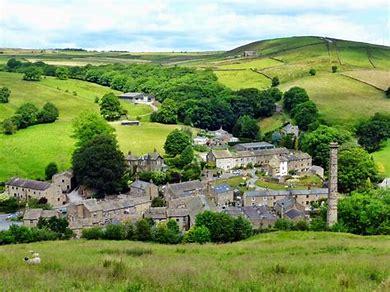
I am particularly interested in suffixes. For example, the names of many villages in the North of England bear the suffix -WICK. This dates from before the Domesday Book (1086) and originally indicated a small, secondary farmstead on land allotted from the main farm. It becomes fascinating when you consider the prefixes that are linked to this stem.
The villages I know well range from the banal Appletreewick (apple tree farm), to the more esoteric Kildwick (river port, but the village doesn't lie on the river), or the mind-boggling Giggleswick (and no, this does not mean a cheerful farm, but rather the farm of a man called Gikel or Gichel).
I also enjoy considering village names that describe the geography of the site. Some of these need no explanation, such as Cross Hills or Crossflats, whereas others are more tricky.
Bradford was thought to be named for the ford crossing the river that ran through the town, but in fact the name means a 'Broad Crossing' of a stream or Beck. There used to be a confluence of at least five rivers at this site, but today there isn't a surface river running through Bradford, they are all lost, running deep below the surface.
Rumour has it that Lothersdale was named when a Norse Viking conqueror looked down on it, and declared "Lo! There's a dale" but this seems to have just been a tale to make English schoolchildren become interested in town names and their histories.
| Author Notes |
The photograph is of Lothersdale in North Yorkshire.
Many thanks to lyenochka / karenina for this great initiative. |
![]()
By lyenochka

We were in the car some time ago, driving between villages in Lincolnshire, England, and I saw a sign that said 'Loose Chippings' at the side of the road. For a few moments, I actually thought we were approaching a village called 'Loose Chippings' rather than some roadworks with the risk of debris. Do you know why I thought that? It's because England has some of the silliest place names you can imagine - often twee, usually dirty-sounding, and mostly worth a visit.
One day, I'll tell the tale of Upper Dicker and its neighbouring village ... Lower Dicker, but they're not quite in my wheelhouse. Instead, let me tell you about Kent, aka The Garden of England. Beloved by the Campaign for Real Ale (CAMRA) for being one of Europe's largest hop-producing regions, Kent is a county on the South East corner of the UK, and encroaches into London. That's where I come in - I live geographically in Greater London, but I have a Kent post code because the administration couldn't keep up with urban sprawl (it's also why I pay council tax to two different places, but I'll save that rant for another day).
Kent has some great place names, and I've found many more whilst looking into it for this article. First, I'll look at some name parts, because when I found a list of all places in Kent from a census taken about a hundred years ago, there were 5 places called Alder Shaw, and about another 30 with one or the other of those words, so let's go:
Alder - Turns out, this is a type of Birch tree, so it's not surprising it found its way into place names.
Shaw - Shaw is an Old English for a wooded area.
Alder Shaw - So this place name means 'Birch Wood.' Hang on a minute, that sounds familiar ... Yes, there are 20 places in Kent alone called Birch Wood. The imagination runs rife around here! Here are some other word parts that crop up lots in local place names:
Hurst - This is appended to many places around here, and means either a hillock (specifically a sandy one) or a wooded grove of noted eminence (old English). There's also the middle English Horst meaning underwood.
Wold - also weald, an actual Kentish word for a wooded upland. There's a theme here. England is covered in two things - trees and hills - so etymology becomes quite predictable!
Bottom - the thing you sit on. Okay, so that's only been true since 1794. Prior to that, it related to ground soil or foundations - essentially, the lowest part of something. Hence, place names ending bottom!
Hole - Yes, you caught me - I did put this straight after 'Bottom' intentionally - I'm an Englishman with an Englishman's love of the puerile! Predictably, hole means exactly that, but in the ground, so caves and carved out spaces - it developed into 'hollow' to mean the excavated habitation of a burrowing animal.
Now you know your bottom from your hole, let's take a look at some specific places in Kent.
Thong - We had to start here, really. Inevitably synonymous with the kind of underwear that makes cheeks blush and turns walking into flossing, no list of amusing place names is complete without Thong. This is a more modern spelling, as its first record is from the year 1200, called Thuange. Some sources believe it comes from the German word dwenge (meaning trap) - the mind boggles!
Babies' Castle - Location of a famous battle where, with all the adults off to war, a team of 300 babies defended their home against the massed forces of Persia by catapulting their used nappies into the enemy ranks, spreading disease and dissent. Yeah, okay, so I made that up. This was actually one of the first children's homes set up by Dr Thomas John Barnardo (founder of the Barnardo's charity). Appalled at the conditions some infants lived in, he set up homes in many locations to provide a roof, sustenance and education. Babies' Castle was a site donated to Barnardo for this specific purpose, and opened in the early 1880s.
Sandwich - when you see an advert demanding 'visit Sandwich!' ... well, who could resist? Sandwich gets its name from the central high street, lined by shops built from bread bricks that have been dried to the point of extreme toughness. The road between them is laid with aged cheddar cheese, and vendors are only allowed to sell sliced tomato. In truth, the name comes from Sand, meaning ... well, sand, and wich (Anglo-Saxon wic), meaning a fortified trade building. Earliest iterations of the name are Sondwic (851) and Sandwic (993), and it's listed in the Domesday Book (1086) as Sandwice. Really, it just means 'trade town built on sandy ground' - but I'd love to walk a cheese roadway someday!
There are so many more, but those are my favourites. For now, I'll take a drive down Knightrider Street and leave you to digest. For those with a hunger, here are some more places to visit in Kent:
Badgers Mount
Ballsdown Farm
Cock Farm
Cradle Bottom Wood
The Devil's Kneading Trough
Dicks Wood
Duckpit
Famine Down
Fifth Quarter
Frogs Bottom
Gaol Wood
Got Eye Wood
Grandson
Hearts Delight
Hell Wood
Knockherdown Hill
Long Nose Spit
World's End
| Author Notes |
I hope you enjoyed reading this as much as I did researching it :-)
Mike |
|
You've read it - now go back to FanStory.com to comment on each chapter and show your thanks to the author! |
![]()
| © Copyright 2015 lyenochka All rights reserved. lyenochka has granted FanStory.com, its affiliates and its syndicates non-exclusive rights to display this work. |
© 2015 FanStory.com, Inc. All Rights Reserved. Terms under which this service is provided to you. Privacy Statement